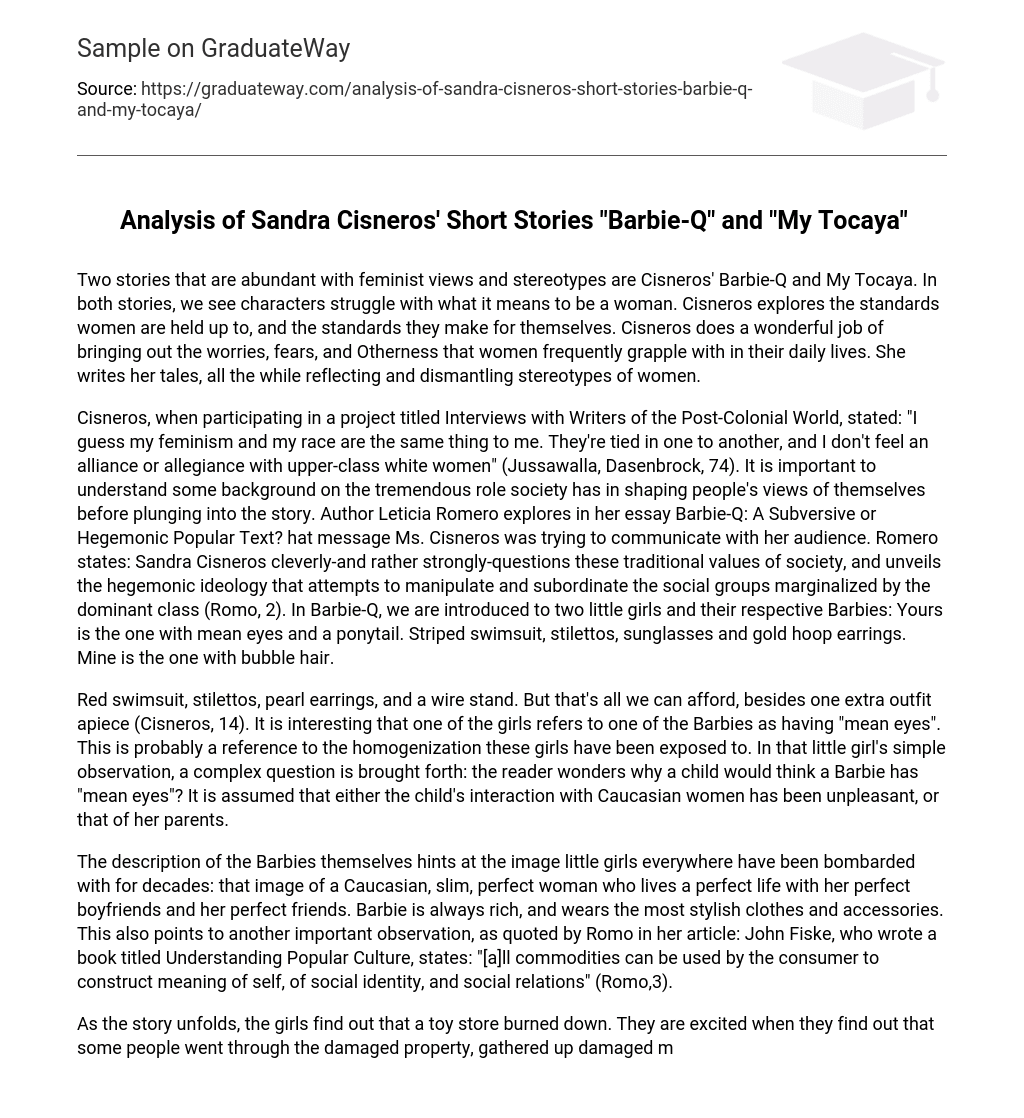Two stories that are abundant with feminist views and stereotypes are Cisneros’ Barbie-Q and My Tocaya. In both stories, we see characters struggle with what it means to be a woman. Cisneros explores the standards women are held up to, and the standards they make for themselves. Cisneros does a wonderful job of bringing out the worries, fears, and Otherness that women frequently grapple with in their daily lives. She writes her tales, all the while reflecting and dismantling stereotypes of women.
Cisneros, when participating in a project titled Interviews with Writers of the Post-Colonial World, stated: “I guess my feminism and my race are the same thing to me. They’re tied in one to another, and I don’t feel an alliance or allegiance with upper-class white women” (Jussawalla, Dasenbrock, 74). It is important to understand some background on the tremendous role society has in shaping people’s views of themselves before plunging into the story. Author Leticia Romero explores in her essay Barbie-Q: A Subversive or Hegemonic Popular Text? hat message Ms. Cisneros was trying to communicate with her audience. Romero states: Sandra Cisneros cleverly-and rather strongly-questions these traditional values of society, and unveils the hegemonic ideology that attempts to manipulate and subordinate the social groups marginalized by the dominant class (Romo, 2). In Barbie-Q, we are introduced to two little girls and their respective Barbies: Yours is the one with mean eyes and a ponytail. Striped swimsuit, stilettos, sunglasses and gold hoop earrings. Mine is the one with bubble hair.
Red swimsuit, stilettos, pearl earrings, and a wire stand. But that’s all we can afford, besides one extra outfit apiece (Cisneros, 14). It is interesting that one of the girls refers to one of the Barbies as having “mean eyes”. This is probably a reference to the homogenization these girls have been exposed to. In that little girl’s simple observation, a complex question is brought forth: the reader wonders why a child would think a Barbie has “mean eyes”? It is assumed that either the child’s interaction with Caucasian women has been unpleasant, or that of her parents.
The description of the Barbies themselves hints at the image little girls everywhere have been bombarded with for decades: that image of a Caucasian, slim, perfect woman who lives a perfect life with her perfect boyfriends and her perfect friends. Barbie is always rich, and wears the most stylish clothes and accessories. This also points to another important observation, as quoted by Romo in her article: John Fiske, who wrote a book titled Understanding Popular Culture, states: “[a]ll commodities can be used by the consumer to construct meaning of self, of social identity, and social relations” (Romo,3).
As the story unfolds, the girls find out that a toy store burned down. They are excited when they find out that some people went through the damaged property, gathered up damaged merchandise, and are now out on the street selling the items. They become especially exuberant when they discover that lots of Barbies are being sold, as well. They eagerly snap up several of the dolls, and in their eagerness, are willing to overlook the smoke and fire damage, and still play with the dolls.
This brings up an important lesson that the girls understand, and others strive for years to comprehend: women may have their imperfections, but they are still valuable, loved, and cherished. One must look beyond the physical beauty to find the inner beauty that is in every woman. The little girls did what many women cannot: be satisfied with what they have, rather than focusing on what they don’t have. Willing to overlook smoke and melted parts and just enjoy the toy the way it is, not the way it is not.
My Tocaya is another story that holds up stereotypes of women to be examined, and also explores what is considered a “good” Spanish girl, and what is considered a “bad” Spanish girl. In this short story, Cisneros delves into explaining not only how society tears women down, but how women tear each other down, as well. By playing with stereotypes, Cisneros examines the diverse cultures and opinions of people within their own races. This story tells the tale of two teenagers who share the same first name of Patricia, and when one of them doesn’t show up at home, she is assumed missing.
The narrator of the story, Patricia Chavez, looks down upon the other Patricia, whose last name is Benevides. Chavez believes there is quite a bit wrong with the other one: Benevides dresses inappropriately, is too studious, too hardworking. When Benevides pronounces her first name with a British accent, Chavez is offended that it isn’t pronounced the Spanish way. When Benevides goes missing, Chavez has no compassion or empathy for the missing girl. All she can think about is how stupid the other girl is, and even seems to be jealous of all the attention the missing girl receives.
When the other girl shows up again, alive and well, instead of feeling relief or happiness, Chavez is still sarcastic and mean, even going so far as to saying that the other girl “couldn’t even die right” (Cisneros, 40). By reading in between the lines of these two stories, one examines the prejudices, injustices, and perceived standards that society, and even some women themselves, are held up to. By breaking down and analyzing standards and stereotypes, one can have a better grasp on not only women’s issues, but the author herself. Ms.
Cisneros has a firm grasp on the issues that surround the women of today. Reference: Charters, A. , (2011). The story and its writer: An introduction to short fiction. Boston, MA: Bedford/St. Martin’s. ISBN: 9780312596248. Mullen, H. (1996). “A silence between us like a language”: The untranslatability of experience in Sandra Cisneros’s woman hollering creek. Melus, 21(2), pp 3-20. doi:10. 2307/467946 Thomson, J. (1994). “What is called heaven”: Identity in Sandra Cisneros’s woman hollering creek. Studies in Short Fiction, 31(3), pp 415 -24.





